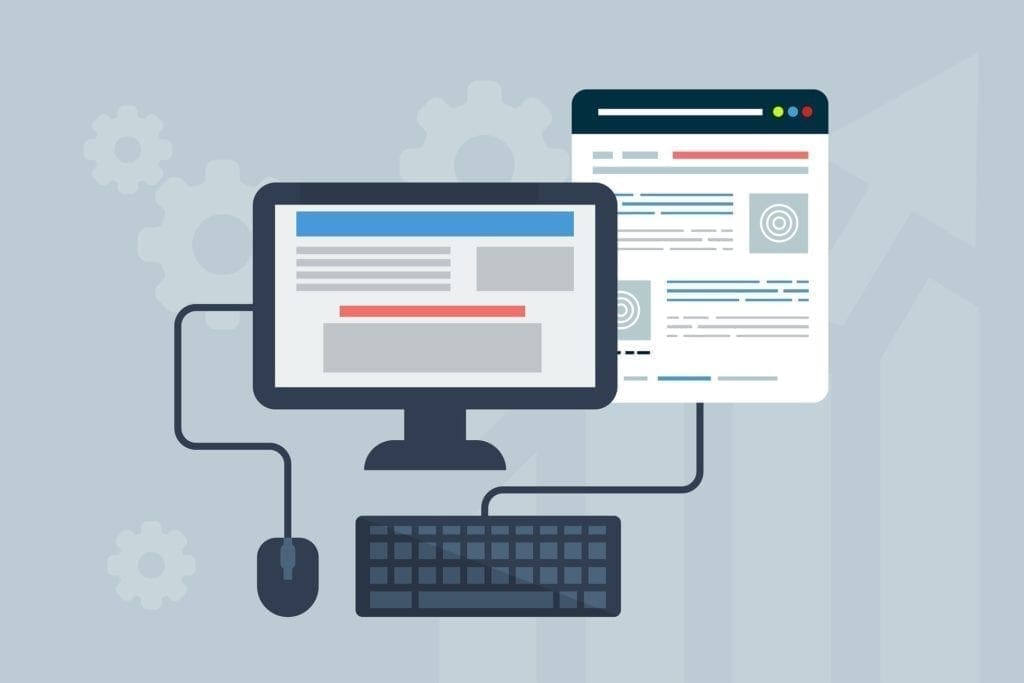You may have seen some of our recent blog posts advising readers of which plugins are best and how to get the most out of your new website, but how do you know when you need to refresh your website and give it a facelift? Having a new website can be potentially expensive, so what factors need to be considered when deciding whether it’s time to have a new website?
Hopefully this article will help answer some of those questions. Let’s start by talking about older websites and see if your current site falls under any of the early descriptions given for static and outdated sites.
A Brief History of Static Vs Dynamic, Responsive Websites
Years ago, most websites were ‘static’ created in software using HTML code or desktop software like Dreamweaver.
A static website can be thought of as a series of individual pages that are linked together by hyperlinks. None of the pages were ‘intelligent’ or dynamically generated from data held within other sources – they were basically just like Microsoft Word documents, with general text information, links and the occasional image.
In order to optimise your website for SEO, webmasters would have to edit the metadata manually on each individual page of the website changing it in accordance with each page’s content. Not only were these websites relatively plain and ugly to look at, it was time consuming to make them, as most things would have to be done manually including CSS (style sheets) to design the web page.

Is it time for a website refresh?
Image credit: Pixelbay / kreatikar
As the years passed, internet speeds increased, as did the demand for websites with ‘rich content’ and mobile friendly designs. As users tried to make their websites better looking and ‘smarter’, the limits of traditional static websites became clearer; introducing the need for dynamic database-driven websites and content management systems .
The Rise of Content Management Systems
The next evolution of websites came when platforms such as Drupal appeared and later WordPress and Joomla.
These Content Management Systems (or ‘CMS’) allowed users to do much more powerful things with their website and as time progressed, the need for coding knowledge became less and less essential when it came to maintaining and even updating websites with new content. These new CMS platforms were smarter, flashier and did everything static websites could do but easier and more efficiently.
For example, to update metadata for SEO, this could be done from a single page and propagated to all relevant pages immediately. You no longer needed to manually edit the page in something like Dreamweaver, change the relevant metadata and then upload the page again via FTP – it was all done from the backend or administrator interface.
Data could be pulled in from different parts of the website to other parts by utilising the underlying PHP and database-driven nature of these platforms, saving massive amounts of time and giving a better user-experience for the users viewing your website.
New functionality could be easily and often freely added using plugins, extensions and add-ons designed by global communities of developers using those CMS platforms.
‘Responsive’ Content Management Systems
As more and more webmasters began to use Content Management Systems, more plugins would be added which gave the platforms even more functionality for other users that might not be able to code.
Over time these plugins (extended pieces of functionality) reached the tens of thousands making it possible for anyone to make a site with any functionality they could possibly think up. Eventually though as time passed, mobile phones and tablets gained popularity and started to become a significant percentage of the platforms that were viewing business websites.
Webmasters realised that their websites were fantastic and very feature rich, but the website they had spent a lot of time creating wasn’t optimised for the small screens of mobile phones and tablets. Also, mobile phones viewing on 3G (at the time) didn’t typically have data speeds or plans to allow for the viewing of websites that were data rich, large in file size and slow to load.
For a while, webmasters thought about making two different versions of their site to solve the above issues (a desktop website and separate mobile site). But as time passed, the ability for having a single responsive website was seen as the way forward and that solved all the problems webmasters were having with no drawbacks.
A responsive website is a site that is designed to change sizing automatically in order to accommodate the device it is being viewed on. This helps give a consistent experience across the board without having to sacrifice content on your website.
Many CMS templates and themes these days are listed as ‘responsive’, meaning they will possess these properties and allow the site to change based on the dimensions of the screen you are viewing on. If you reshape the window of a responsive website while on a PC, you will see this in action as the menu items and images will typically realign to give the most optimal experience to the user.
This brings us where we are today, where users can enjoy a feature-rich CMS platforms with optimised images and video content suitable for all devices by utilising responsive design.
Factors to Consider When Deciding if it’s Time for a Website Refresh
Hopefully now I’ve given you the backstory on the history of websites and it will be easier to identify the potential shortcomings of your own website.
It is essential in 2019 and beyond that your website is a database-driven, responsive site that can be easily managed and optimised for SEO. This isn’t just to give your users a modern optimal experience (even though that is a significant part of it) but all of the above can help with SEO therefor being of a direct benefit to your business by providing a ROI on any expense invested in the website refresh.
Here are some main points that you can expect to benefit from if you are redesigning your site in 2019:
- Database driven websites make everything on your site connected. Want to show the latest blog posts by a certain user on the front page of your website? Not a problem, you can set this up in literally a matter of minutes.
- Security is obviously a very important factor to consider when running a website. Regardless of which CMS you choose, you can expect plugins and extensions that not only give high security but run automated FTP and database backups at manually specified time periods. You can even choose to back these up to your cloud-based storage provider such as Dropbox or Google Drive – all completely automatic! Updates to the CMS core happen automatically too meaning you are always UpToDate with the latest security patches (similar to how windows update works)
- Responsive websites give a unified optimised experience to all of your users irrespective of devices type, OS, screen size. Your website will always look how you want it to. Obviously if you care about your brand, continuity is very important.
- Due to the modular nature of CMS, your new website will be future proof. Any new functionality released in the coming years will be able to integrate it by simply installing the relevant extension / plugin for the feature set.
- Multiple website authors/moderators are possible on CMS platforms like WordPress. This gives multiple users the ability to edit or add to content on the website. You can restrict certain accounts to limit what can or cannot be edited and it can all be done with a user friendly UI – as always, no coding experience required and is very intuitive for those not tech savvy.
Is it Expensive to Create a New Website?
One of the amazing benefits of open source platforms like WordPress, is that websites can be built cost effectively and with a low total cost of ownership. That means, when it’s time for a website refresh, you don’t need to spend massive amounts of money to give your site a facelift.
If you are a small business that desperately needs a new website but has a tight budget, then you can always jump in yourself and try to purchase your own template/theme on a website such as Theme Forest which will allow you to have all of the visual aspects ready to go without hiring a graphic designer.
The expense of having a new website scales relative to what is being created and what you wish to have in terms of design, content and functionality. Some of these can be easily added, and some may require a more bespoke and specialist solution to achieve the desired outcome.
A good DIY starting point would be to download WordPress for free and get stuck in with seeing what you can create on a test domain while still having your current website live. If even that is too pricy, you can download WordPress and install it locally on your desktop PC – a great guide on doing this by WPBeginner can be found here.
If you do manage to come up with something that you like, there are numerous WordPress tools that allow for website migration to different domains with minimal effort. If you have made progress but ended up running into a brick wall, you can always hand the site over to a web design agency to pick up where you left off.
Getting Help
If you are a small business or have a small marketing team, you might not have the time to carry out a website refresh, which is why a web design agency such as Opace can step in and get to work for you. Obviously as with anything remotely technical, it’s always best to get specialists involved that are experienced with these things, so that you don’t have to worry yourself with any technical hurdles and can stick to what you do best – running your business! If you wish to talk to us about your web design or SEO requirements, please get in touch with by using our contact form or giving us a call on 0121 468 0600.






0 Comments